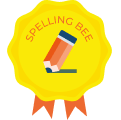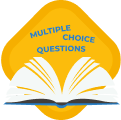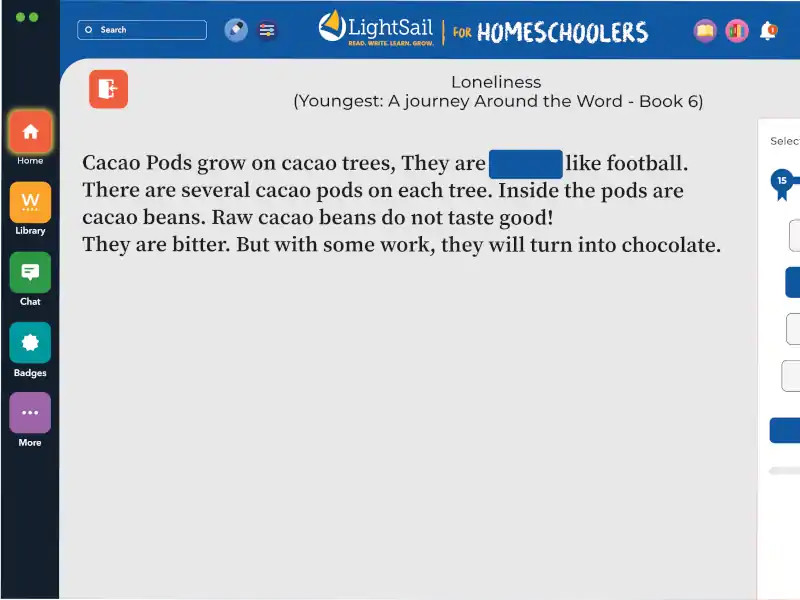Vocabulario
¡MEJORA TUS HABILIDADES DE VOCABULARIO!
Aprende vocabulario con contexto para una máxima comprensión, con rastreadores especializados para enfocarse solo en las palabras nuevas.
Basic Spelling Rules
- Short-Vowel Rule: When one-syllable words have a vowel in the middle, the vowel usually has a short sound. Examples: cat, dog, man, hat, mom, dad, got. If the letter after the vowel is f, l, or s, this letter is often doubled. Examples: staff, ball, pass.
- Two-Vowels Together: When two vowels are next to each other, the first vowel is usually long (the sound is the same as the sound of the letter) and the second vowel is silent. Examples: meat, seat, plain, rain, goat, road, lie, pie.
- Vowel-Consonant-e Pattern: When a short word, or the last syllable of a longer word, ends in this pattern vowel-consonant-e, then the first vowel is usually long and the e is silent. Examples: place, cake, mice, vote, mute.
- Y as a long I: The letter y makes the long sound of i when it comes at the end of a short word that has no other vowel. Examples: cry, try, my, fly, by, hi.
- Y as a long E: When y or ey ends a word in an unaccented syllable, the y has the long sound of e. Examples: money, honey, many, key, funny.
- I before E: Write i before e when the sound is long e except after the letter c. Examples: relieve, relief, reprieve. When there is a c preceding, then it is ei : receipt, receive, ceiling, deceive, conceive.
- E before I: Write e before i when the sound is long a. Examples: weight, freight, reign. Another way to remember this is: “I before e except after c, or when sounding like a as in neighbor and weigh.” When the ie/ei combination is not pronounced ee, it is usually spelled ei.
- Oi or Oy: Use oi in the middle of a word and use oy at the end of a word. Examples: boil, soil, toil, boy, toy.
- Ou or Ow: Use ou in the middle of a word and use ow at the end of words other than those that end in n or d. Examples: mouse, house, found, mount, borrow, row, throw, crow.
- Double Consonants: When b, d, g, m, n, or p appear after a short vowel in a word with two syllables, double the consonant. Examples: rabbit, manner, dagger, banner, drummer.
- The ch sound: At the beginning of a word, use ch. At the end of a word, use tch. When the ch sound is followed by ure or ion, use t. Examples: choose, champ, watch, catch, picture, rapture.
All 220 Dolch words by grade in frequency order
| Pre-Primer | Primer | First Grade | Second Grade | Third Grade | |||||
| the | one | he | now | of | take | would | write | if | full |
| to | my | was | no | his | every | very | always | long | done |
| and | me | that | came | had | old | your | made | about | light |
| a | big | she | ride | him | by | its | gave | got | pick |
| I | come | on | into | her | after | around | us | six | hurt |
| you | blue | they | good | some | think | don't | buy | never | cut |
| it | red | but | want | as | let | right | those | seven | kind |
| in | where | at | too | then | going | green | use | eight | fall |
| said | jump | with | pretty | could | walk | their | fast | today | carry |
| for | away | all | four | when | again | call | pull | myself | small |
| up | here | there | saw | were | may | sleep | both | much | own |
| look | help | out | well | them | stop | five | sit | keep | show |
| is | make | be | ran | ask | fly | wash | which | try | hot |
| go | yellow | have | brown | an | round | or | read | start | far |
| we | two | am | eat | over | give | before | why | ten | draw |
| little | play | do | who | just | once | been | found | bring | clean |
| down | run | did | new | from | open | off | because | drink | grow |
| can | find | what | must | any | has | cold | best | only | together |
| see | three | so | black | how | live | tell | upon | better | shall |
| not | funny | get | white | know | thank | work | these | hold | laugh |
| like | soon | put | first | sing | warm | ||||
| this | our | does | wish | ||||||
| will | ate | goes | many | ||||||
| yes | say | ||||||||
| went | under | ||||||||
| are | please | ||||||||
http://www.dolchword.net/

🎉 Correct Answer!
You are absolutly right!
Keep going!

Incorrect Answer!
Don't Give Up and Try Again!
¡Características estelares!
¡Herramientas del siglo XXI para niños modernos! Con más de 100 funciones ajustables, LightSail se convierte en una plataforma personalizada y específica para satisfacer las necesidades de tu hijo.
¡Descubra cómo la biblioteca de LightSail se adapta al nivel de lectura de tu hijo (a)!




Aprende cómo LightSail usa la
Ludificación
Compra uno
Por cada suscripción de LightSail que compres para tu familia…
Dona uno
… la fundación de LightSail lo igualará y donará una suscripción a la organización benéfica de tu elección.

Nuestra garantía 30-5-3
30 minutos al día + 5 días a la semana + 3 meses = La mejora del nivel de independencia de lectura de tu hijo GARANTIZADA.*

¡Estamos aquí para ayudar!
Encuentra respuestas a preguntas frecuentes o contáctanos para obtener más ayuda.
Puedes enviarnos un correo electrónico a
¿Cómo sé qué libros son adecuados para mi hijo?
LightSail elimina las conjeturas a la hora de elegir libros para tu hijo al adaptar la biblioteca de cada niño a su nivel de lectura preciso.
Al perfeccionar la puntuación de lectura LexileⓇ precisa de un niño, LightSail puede asignarle libros que se encuentren en ese nivel "justo" para promover un progreso de lectura óptimo.
Y debido a que LightSail contiene una variedad tan amplia de contenido, siempre hay una amplia selección de libros para cualquier tema o interés.
¿Para qué edades/grados es LightSail?
Las suscripciones Premium y Standard de LightSail están diseñadas para niños desde el 3º al 12º (de 8 a 18 años).
También tenemos una suscripción a World Book Kids para los 1º y 2º (de 5 a 7 años) y una suscripción a World Book Early Learners para preescolar y kínder (de 2 a 5 años).
¿LightSail es diferente a un Kindle de Amazon o a otros lectores electrónicos?
A diferencia de los lectores electrónicos estáticos, LightSail no solo ofrece libros para niños.
Cada libro y artículo de LightSail contiene 6 capas de funciones adicionales que permiten que su hijo experimente los libros.
Al adaptarse a la capacidad de lectura precisa de un niño, ofrecerle contenido que se encuentra en el nivel de lectura "justo" para promover el crecimiento de la alfabetización y brindar una experiencia de lectura gratificante y totalmente personalizable, LightSail desbloquea la magia de la lectura de maneras en las que ningún libro físico o lector electrónico estático pueden.
¿Qué tipo de control parental tengo sobre la actividad y el contenido de mi hijo?
En pocas palabras: control total.
LightSail contiene un conjunto completo de funciones de control parental que gobiernan todos los aspectos de la plataforma, desde la visualización de videos hasta los chats y el contenido que se puede ver y acceder.
Además, los revolucionarios controles de contenido ChildSafe de LightSail permiten a los padres filtrar y bloquear contenido de acuerdo con docenas de subcategorías matizadas basadas en factores de madurez, valores familiares y temas religiosos.
¿Cómo puedo hacer que la lectura sea divertida para mi hijo?
LightSail incorpora funciones de ludificación en todos los aspectos de la plataforma, ¡especialmente en la lectura!
Al integrar insignias, objetivos e hitos, opciones para compartir en redes sociales, mensajes de motivación y la capacidad de los padres para agregar recompensas de regalo personalizables, LightSail incentiva la lectura, la escritura y el aprendizaje de la misma manera en que lo hacen los juegos favoritos de los niños.
















